December 25, 2015
Air Date: December 25, 2015
FULL SHOW
SEGMENTS
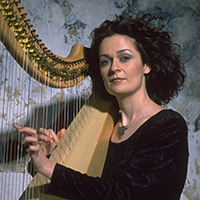
Aine Minogue Celebrates Hope In Celtic Holiday Traditions
View the page for this story
Irish harpist Aine Minogue launches the Living on Earth holiday special, with stories of mid-winter traditions. Aine and host Steve Curwood discuss the importancee of visiting friends, decorating with evergreens, and summoning longer days, and she plays traditional tunes of the season and sings about a creature from the Land Beneath the Sea. (10:30)
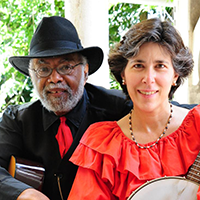
Sparky and Rhonda Rucker Celebrate Hope in the Traditions of Slaves
View the page for this story
Slaves in the American South sang and shared stories to keep their sense of hope alive. Husband and wife duo Sparky and Rhonda Rucker share stories of what slaves could expect at the holiday season, and a hog tale of the trickster High John the Conqueror, along with old-time spirituals. (20:15)
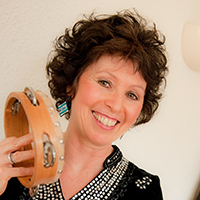
Stories of Hope from Noa Baum
View the page for this story
Israeli-American storyteller Noa Baum believes that sharing stories keeps hope alive, and she has two examples to demonstrate. First there’s a traditional, Eastern European tale about the importance of stories, and the true recollection of a Pakistani who discovers that his family tree includes people from all over the world and of all faiths. (16:20)
Show Credits and Funders
Show Transcript
HOST: Steve Curwood
GUESTS: Aine Minogue, Sparky and Rhonda Rucker, Noa Baum
[HARP MUSIC: Aine Minogue, "Dove's Return," performed live in-studio, not commercially available]
CURWOOD: From Public Radio International, this is Living on Earth.
CURWOOD: I'm Steve Curwood. We have different music today because it’s our Holiday Special – A chance to get away from the rush of environmental news, to relax, and listen to some music, including the sweet sounds of the Irish harp. And we’ll have stories as well, some sad, and some that emphasize the unity of humanity in the face of rampant hate, as when a Pakistani man shows his son the book that lists all his family’s ancestors.
BAUM: His father said, “You asked about the hate, remember? I wanted you to see this, I wanted you to see that God lives in everything, and don’t you ever let anyone tell you to hate another because you could see, they’re all here — Muslims, Sikhs, Hindus, Christians, Jews — they’re all your family.”
CURWOOD: That and more this week on Living on Earth. Stick around.
[NEWSBREAK MUSIC: Boards of Canada “Zoetrope” from “In a Beautiful Place Out in the Country” (Warp Records 2000)]
ANNOUNCER: Support for Living on Earth comes from United Technologies – innovating to make the world a better, more sustainable, place to live.
[MUSIC: Aine Minogue, “Hunting the Wren,” performed live in-studio, not commercially available]
Aine Minogue Celebrates Hope In Celtic Holiday Traditions
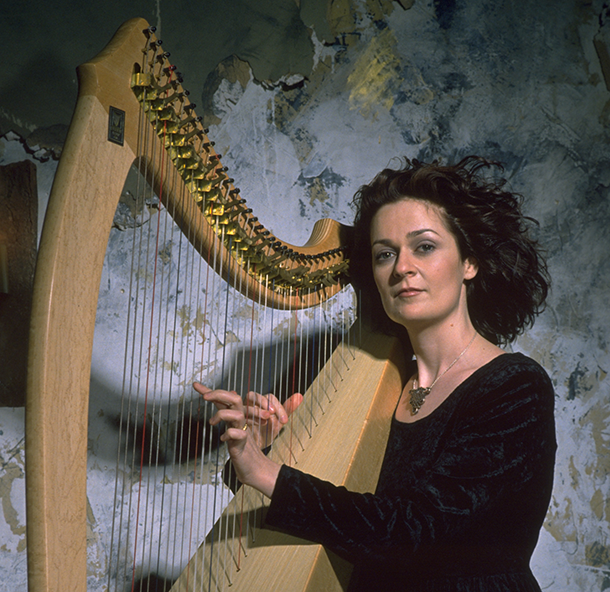
Áine Minogue is a harpist originally from County Tipperary, Ireland. She lives in the Boston, MA area. (Photo: courtesy of Aine Minogue)
CURWOOD: From the Jennifer and Ted Stanley Studios at the University of Massachusetts Boston and PRI, it’s the Living on Earth holiday special. I’m Steve Curwood.
[HARP MUSIC: Aine Minogue, “A Winter Story,” performed live in-studio, not commercially available]
CURWOOD: Our theme today is hope at this time of short days and new years. And we’re listening to an Irish harp as we begin with a visit to the magical world of brownies and leprechauns and kelpies and faeries of the ancient Celtic culture, another world that Celts felt they could glimpse from this one, especially at this time of year. Singer, storyteller and harpist Aine Minogue is our guide, and she joins us now with an old-fashioned horn dance, the traditional dance of hunting the wren and the mysterious selkie. Aine Minogue, welcome to Living on Earth.
MINOGUE: Thank you, Steve.
CURWOOD: So, our theme today is hope, but in northern Europe, the land of the Celts, the days are, well, they're extraordinarily short this time of year. All that darkness. How could people get a sense of hope?
MINOGUE: Well, it seems to be intrinsic to the human condition, and long before there was a Christmas or a Hanukkah or a Kwanzaa, mid-winter was a holy time, I think, for people not just in the Celtic countries but all over the world. And it my culture, the old Irish and Celtic tradition, the world was seen as a wheel of life and each season was like a journey. None was more deeply felt than the journey of December through the winter months, and the winter solstice in particular, which is the year's shortest day. So there were rituals of the season, and they weren’t simply for merriment. They serve as a great function and, because it was such a dark month, it was kind of dangerous. It's very hard for us to think of a time before electricity. A lot of these traditions involve going door to door, and it was very important to check in on your neighbors, checking the wood pile and making sure everybody was safe and well. So, a lot of these traditions of going door to door served that function very usefully.
[HARP MUSIC]
This dance, called the “Horn Dance,” is a wonderful dance. Eight men ran through the village with antler heads, and it was thought to bring in good luck for the new year and it's still performed today in Abbots Bromley in Staffordshire on New Year's Day. It's an unbroken tradition.
[MUSIC: Aine Minogue, “Horn Dance,” performed live in-studio, not commercially available]
CURWOOD: Now what about the other traditional dance called "Hunting the Wren"? What’s that all about?
MINOGUE: Well, "Hunting the Wren" is an unbroken tradition that's gone on in Ireland as long as anyone can remember. Originally, it's believed that St. Steven was betrayed by a chattering wren. Also, before that, it's believed the wren was the wisest of all birds, and used to be hunted down and passed around, again, to bring good luck for the new year. So the tradition is people go from house to house, playing music. It's another one of the visiting traditions, and we play for people and play music and pass the hat. And Wren Boys, they often dress up actually in straw. They're often called “Straw Boys.” A lot of tomfoolery going on. It’s good fun.
CURWOOD: And this is the day after Christmas.
MINOGUE: It's the day after Christmas Day, which is a fantastic day to leave the house, get up after all that food and move about the countryside. It's a huge visiting day. I used to do it and have written a little piece here for you that I hope you'll enjoy.
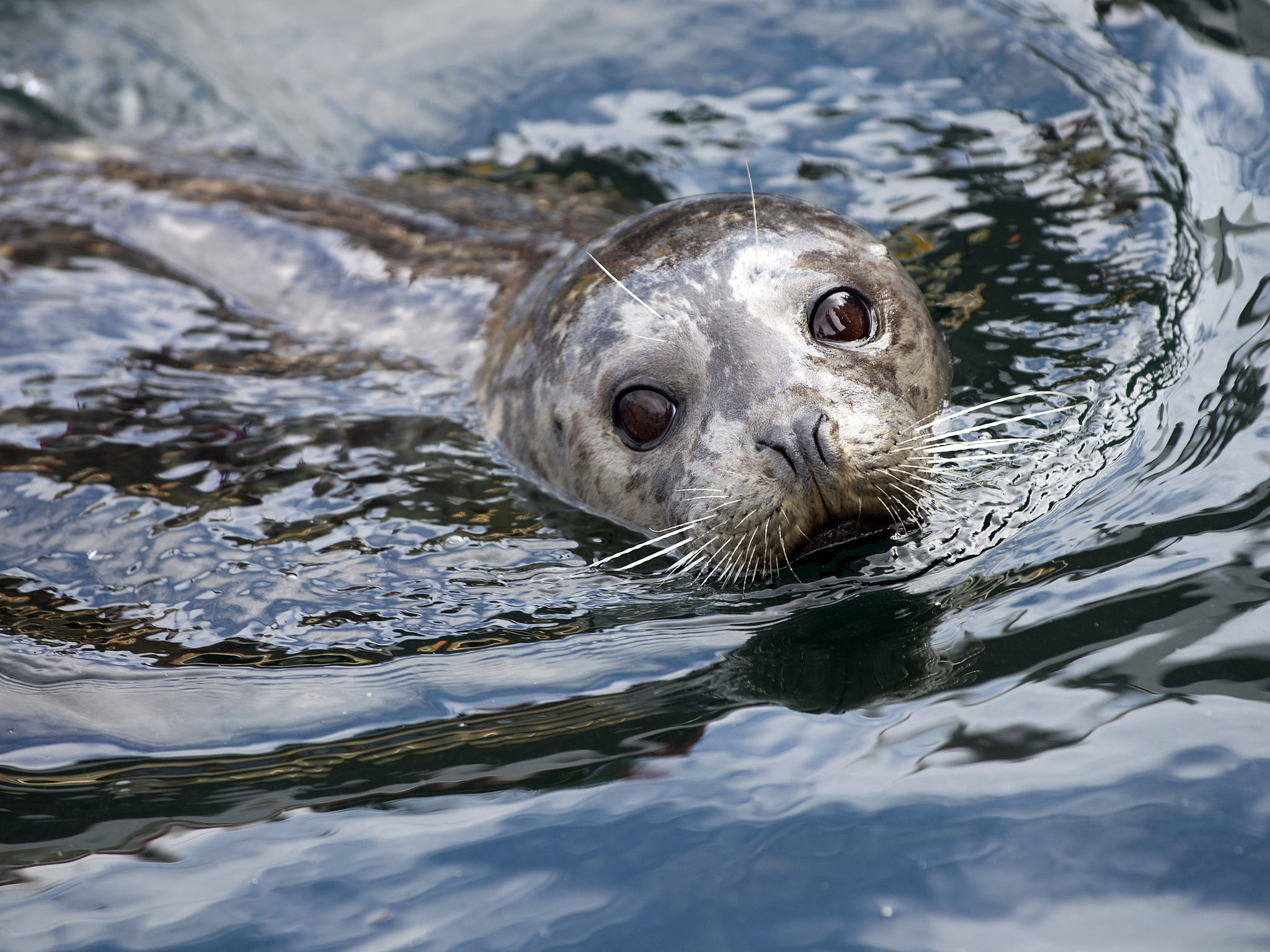
Selkies are mythological Celtic creatures that are said to live as seals in the sea but shed their skin to become human on land. (Photo: RayMorris1, Flickr CC BY-NC-ND 2.0)
[MUSIC: Aine Minogue, “Hunting the Wren,” performed live in-studio, not commercially available]
CURWOOD: So this is a powerful time of year for the Celtic world, but what about those beliefs that especially at this time of year one could just slip between the world of everyday and the world of gods and faeries?
MINOGUE: Yes, I think that idea of sort of a crack between here and the other world is very prevalent at that time of year. And the Celts believed that the veil between the worlds was very thin, and that we might see the ancients or the gods, and the gods might see us. Anything in states of between-ness was very, very powerful, so you wanted to be somewhere that was, like by the seashore, which was neither land nor sea. And even holly was considered powerful at that time because it was neither tree nor bush. And they loved places where parishes met or waters met or even roads met because these were, again, seams or cracks, just like cracks in the year, and therefore they had their own sense of magic about them.
CURWOOD: Well, tell me more. What were these other words?
MINOGUE: Well, broadly speaking, within the Irish tradition, there were three other worlds. One was the land beneath the ground, and the other was Tìr na nÒg, which translates from the Gaelic to the Land Of Perpetual Youth. And then there's the Land Beneath the Sea. What we have to remember about this whole other world is that when people are very close to the land and agricultural cycle, it's so real to them. And when people sort of live and work on the sea, the idea of having their other world beneath them, and these creatures coming to life, their stories are based on these ideas, as opposed to a heaven which we’re much more familiar with.
CURWOOD: And, Aine, what about this notion that people can interact with creatures from other worlds. I'm thinking in particular of the selkie — the creature from underneath the sea.
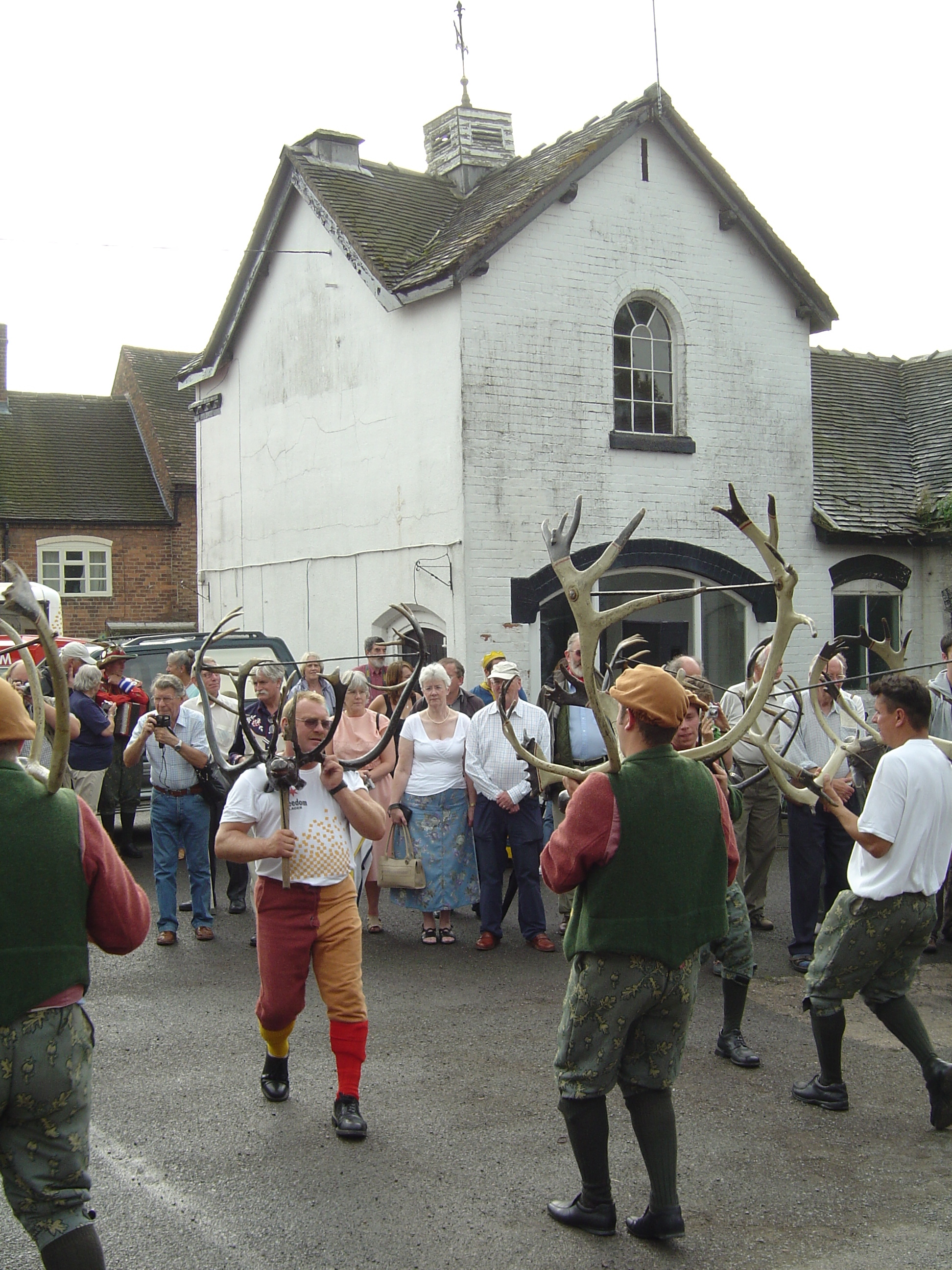
Townsmen perform the horn dance. (Photo: Optimist on the run, Wikimedia CC BY-SA 3.0)
MINOGUE: So, the selkie is basically a seal, and a human man or woman falls in love with this seal and gets the seal to agree to come to land, and sometimes it's through trickery, but usually they actually fall in love. And the seal sheds her skin, and sometimes he hides the skin for her, or sometimes she hides it herself, and invariably over time either she finds the skin or one of her children do, and she just feels compelled. She can't help herself. She puts it back on. And of course when she does she has to return to the water because that's her true home, and it creates great sadness.
CURWOOD: So, Aine, I understand you have a song that describes this doomed love. Please, sing it for us now.
MINOGUE: Of course.
[MUSIC: Aine Minogue, “The Selkie Song,” traditional Scottish, recorded live, in-studio, not commercially available]
THE SELKIE SONG
I am a man upon the land,
I am a selkie in the sea,
When I'm far, and far from land,
My dwelling, it’s in Sule Skerry.
It shall come to pass on a summer's day,
As the sun shines hot on every stone,
That I shall take my little young son,
And teach him for to swim the foam.
It was not well, said the maiden fair,
It was not well, indeed, said she,
That the Great Selkie of Sule Skerry,
Should have come and brought a babe to me.
CURWOOD: That’s such a sad story. Before you go, I seem to remember that the bonfire was big at ancient winter solstice festivals. Why?
MINOGUE: I think, you know, particularly in western Europe this time of year, the idea, I think, was that the fire would beseech the year to stay alive, like literally, keep the sun in the sky. And all of these festivals are really festivals of light, and it's literally a means of keeping the year alive. I often think of John Lennon. He always said, "If you're not busy being born, you're busy dying." Probably the old Irish would have said, “We're busy being born and busy dying,” that we have that vital system that both are always going on at the same time, and that Solstice, it's just that one moment where it all stops, just for a moment.
CURWOOD: Aine Minogue, you’ve taken us to the horn dance, we’ve hunted the wren. We've met a selkie. So now, please give us some hope for the New Year that’s coming.
MINOGUE: Well I always love to turn to the words of Susan Cooper and one of my favorite poems that get me through the winter. It's called, "The Shortest Day".
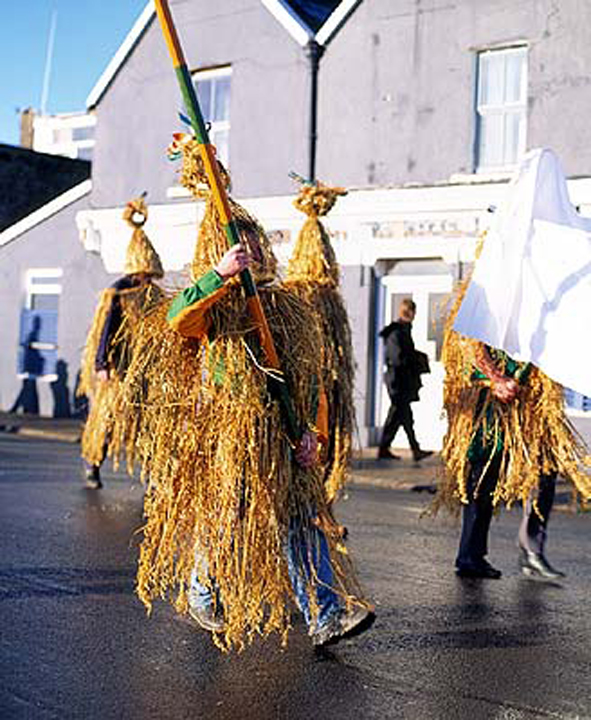
Wrenboys on St. Stephen's Day in Dingle, Ireland, December 26th. (Photo: National Library of Ireland on The Commons, Flickr CC public domain)
So the shortest day came, and the year died,
And everywhere down the centuries of the snow-white world
Came people singing, dancing,
To drive the dark away.
They lighted candles in the winter trees;
They hung their homes with evergreen;
They burned beseeching fires all night long
To keep the year alive,
And when the new year's sunshine blazed awake
They shouted, reveling.
Through all the frosty ages you can hear them
Echoing behind us - Listen!
All the long echoes sing the same delight,
This shortest day,
As promise wakens in the sleeping land:
They carol, fest, give thanks,
And dearly love their friends,
And hope for peace.
And so do we, here, now,
This year and every year.
Welcome Yule!
CURWOOD: Welcome Yule! Aine Minogue is a harpist and folklorist from Tipperary. These days she celebrates the season in Boston.
[MUSIC: Aine Minogue et al, “Greensleeves,” Rounder Records]
Related links:
- More about Áine Minogue and her musical tales
- About the Abbots Bromley Horn Dance
- Legend behind “The Selkie Song”
- Susan Cooper’s poem “The Shortest Day”
CURWOOD: Just ahead … the tale of High John the Conqueror and how he scored a good pig dinner. Stay tuned to Living on Earth.
[CUTAWAY MUSIC: Aine Minogue et al, “Christmas Capers,” Rounder Records]
Sparky and Rhonda Rucker Celebrate Hope in the Traditions of Slaves
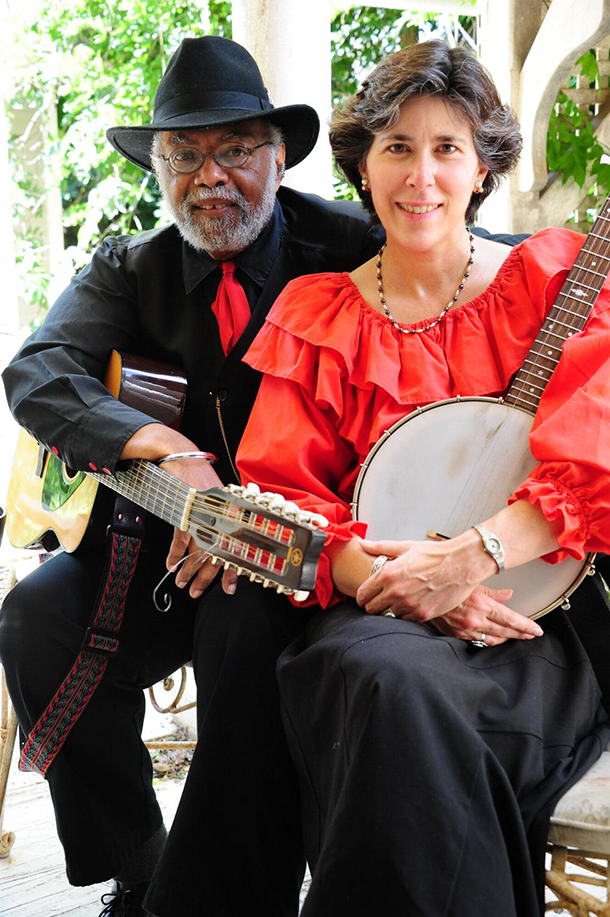
Multi-instrumentalists Sparky and Rhonda Ruckers sing songs and tell stories from the American folk tradition. (Photo: courtesy of Pam Zappardino)
CURWOOD: It's the Living on Earth holiday special, I'm Steve Curwood.
[MUSIC: Sparky and Rhonda Rucker, “Blues At Winter Solstice,” original tune recorded live in-studio, not commercially available]
CURWOOD: At this time we take a break from the pressing issues in the news cycle and celebrate the season with storytelling. And we’re listening to music from Sparky and Rhonda Rucker now. They’re a husband-and-wife duo, folk and blues musicians and storytellers based in Tennessee. Their performances are filled with original and traditional songs and tales. Welcome to Living on Earth.
RHONDA: Well, thank you.
SPARKY: Yeah, thank you, Steve, good to be here.
CURWOOD: Now, as I understand it, both of you have preachers in your family. How much did life revolve around the church?
SPARKY: Well, I'll tell you, in my family it was everything. My grandfather, Bishop John Lindsey Rucker of the Church o’ God, comma, Sanctified Church! And I always liked to say it that way because, you know, just by the very name of it, it implies that all of the other churches are not sanctified. You know that old saying, “Everyone thinks they're going be the only ones gonna be in heaven, you know. [LAUGHS]
CURWOOD: How about you, Rhonda?
RHONDA: Yeah, my uncle was a preacher. He was a preacher in the Methodist Church, excuse me, the United Methodist Church, comma, Unsanctified. [LAUGHS] But they move people around in the Methodist Church, and the preachers, they kind of do musical chairs every so often, and so he would be moved in various places out in the state of Kentucky, and so, come holiday season, that's where we would go. We'd go to their house and everybody would gather there, but it was always a new town that we were going to, a new house and whatnot, but it was great gathering. That’s one of my favorite things about the holidays, is getting to be around the family members.
SPARKY: Yeah, especially gathering together with the family and, you know, I was fortunate to get to know my grandmother. There at my grandmothers table, gosh, she was a wonderful cook. She could cook the beaten biscuits, and I know a lot of people don't know about beaten biscuits, but there was a special way that she’d mix ‘em up and then they put these put these fork holes in ‘em, and she would put ‘em in a big old mixing bowl and put a linen cloth over the top of ‘em, and they would stay fresh for a week. And the reason I know that because she’d cook ‘em on Sunday and I’d come over there the next Saturday, and, before I'd say anything else, I'd come running in and she'd just point to the kitchen.
"They're in there."
And I'd go in and grab one of those biscuits out of that bowl, bite into it, it was just like it had just come out of the oven. Oh, and of course, like I said, it was a big family. There were six boys, six girls in the family and every one of those women had their own specialty that they would cook. My aunt Babe, she made chow-chow. Now I don't know if northern folk know about chow-chow, but some people, I guess they call it “relish.” [LAUGHS] But we actually call it “cha-cha,” and she would make this stuff and, I mean, it was hot. You know, it had peppers and cabbage in it, and whatnot, and, ya’ know, she died with that recipe. Nobody ever learned how to make Aunt Babe's cha-cha. But, you know what? Everybody had jars of it after she died. It was like gold. You'd be at a meal and somebody’d go in and come out with a jar and they'd say, "I've got one of Aunt Babe's jars of cha-cha." And it was after she had died, and there we were, sitting there eatin’ that cha-cha. Oh, it was good.
RHONDA: It was her legacy. [LAUGHS]
SPARKY: And, you know, it's what you put on pinto beans and turnip greens. Oh, it was good!
CURWOOD: Rhonda, what was it like for you at the holidays when it came to food?
RHONDA: Well, we usually had turkey and dressing and that kind of thing on holidays, and somebody usually did a ham as well, but I tell you what excited me more than anything was the dessert, and it usually included chocolate, [LAUGHS] which I still love. We would go to my aunt's house. She always bought these ice cream things that were in the shape of a Christmas tree or a Santa Claus or something like that—
SPARKY: Aunt Elsie.
RHONDA: —Aunt Elsie, yeah, and, boy, we just didn't get that at home, you know, my mom wouldn't do that. But the big thing was being around all my cousins and visiting and that kind of thing.
SPARKY: Oh yeah. You're all sitting around this huge, huge table and everybody telling stories. So it was a wonderful time. Then the church, oh, man, there was some wonderful people in church. In fact, I'm old enough that there was always somebody down in the front row in the “Amen Corner” and people whispering, "You know, that’s Sister Lucy. You know, Sister Lucy used to be a slave.” And it's amazing to me to realize that in my lifetime I met people who’d been slaves.
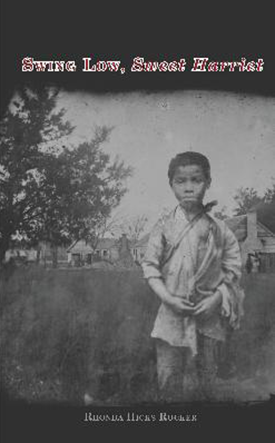
Rhonda Rucker is the author of “Swing Low, Sweet Harriet”, a historical novel based on Harriet Tubman’s work as a spy and scout during the Civil War. (Photo: courtesy of Rhonda Rucker)
CURWOOD: So, Sparky, you're not only a performer but you're a historian of sorts, and a teller of traditional African-American tales. And I understand that some of your stories do go back to slave times. Now, our theme for this holiday special is hope. What was there in the way of hope for slaves on a plantation in the south?
SPARKY: Well, you know, Christmas, for one thing, it meant you would have a couple of days off, and it was time for you to get that one present from the master and usually it was just another pair shoes so you wouldn't have trouble working out there in the fields, or if you were one of the younger kids, you'd get a new — you know, the kids usually ran barefoot but they'd get this one, sort of a long shirt that they would wear that would come down to about their knees. But it also meant that they would get finally one good meal. The master would maybe let the slaves have one of his suckling pigs. And that was a story that they used to tell.
You know, every culture has tricksters. The people who come from the British Isles, they tell stories about Jack, the Jack tales: Jack and the beanstalk, Jack the giant killer. The, uh, Native Americans, they would tell stories about Old Man Coyote. He was the trickster. You know, the trickster is there not to be something mean to you, but the trickster’s there to give you another way. You know, it’s like coming to a fork in the road, the trickster’s there make you take the road you wouldn’t take, and that’s to keep your life from becoming so stale.
And so they would tell stories to the kids about Br'er Rabbit because, you know, Br'er Rabbit was the rabbit that — he was the animal that all the other animals, even though they were supposed to be his friends, they were all meat eaters. Br'er Rabbit was a vegetarian. And of course, Br'er Rabbit was also on the menu for everybody else. So he had — he was too small to be able to fight Br'er Bear, Br'er Fox, and Br'er Wolf, so he had to use his brains instead of his brawn to overcome. But, when the slaves at night, the adults, they wouldn't tell the stories of Br'er Rabbit to each other, but they’d tell stories about a slave who could not be controlled, who was a trickster, and his name was High John the Conqueror, and one of my favorite stories is telling about John and the master's pigs.
Because John — you know, even today everybody's always talking about bacon, everything and all the hamburger places are always talking about loading bacon on the things and whatnot.
Well, with that suckling pig, you know, just coming around once a year, John kept thinking,
"Well, I oughta be able to have some suckling pig more than once a year.” And he'd notice, you know, “the master, there's just lots of them running around squealing and stinking up the place. Seems like he wouldn't miss if I just took one pig.”
And so, John kept thinking about that and finally one night the devil got a-hold to him or something there, and he said, "I've got to go and get me one of their pigs."
So he snuck in, climbed over the fence, picked up one of them. [SQUEALING] He run back down to the cabin and took that thing in, and cut him open, dressed him up there, and put him and cut him up, put him in the pot -- big old iron pot, you know, the kind that you can hang over the fireplace there -- and he just let that thing cook down, just cook it on down, oh, ‘til the meat was just falling off the bone and it just smelled so good. And he had him some cornpone left over from the night before and he'd take that, you know, and he'd sop it in the gravy, and oh, he was, oh, that was just, lay back and belching, you know. Oh, this was a good meal, you know.
Well, the next day, he couldn't get the taste of that pig out of his mouth, and he kept thinkin’ about it, and he kept thinkin’, “Well, you know, seems like maybe I can get me one more pig. You know, the master — well you know, there's so many of them."
So that night he got him another pig. Well, that happened, six, seven days and finally, you know, even the master started noticing.
"Uhh, seems like I had more pigs around here than this." And, you know, John was his overseer. So he called, John. “John, have you noticed that some of the pigs been missing?"
"You know, uh, Master, you know, I heard some barking down in the cane break, and I believe there's a family of foxes down there and I believe ole’ Br’er Fox been in there and got one of them pigs, you know."
"Well, John, we better try to keep ‘em out of..."
So John’s like, "Man I got away from that! Maybe I better to go back eating possum again, and…”
But, you know, once you done had the taste of pig, possum just won't do, you know, and so after a couple of days eating possum, he said,
"Maybe the master forgot about it. Maybe I can just go in there and get me another, another one o’them squealers."
So sure enough, he went down there two or three nights, got him a pig, cooked it up, and the master starting noticing again.
He said, "You know, I'll be, that fox is just gettin’ me. I'm gonna to have to go down there and check on this myself."
So that night, Master went down, hid up in the bushes, and had his eye on the pig pen there, and, sure enough, he saw something kind of heading toward the pig pen there, and he said,
“Well, you know, that, that looks too big to be a fox. Why, why, you know, I believe, I believe that's John!”
And, sure enough, John climbed over the fence, got the [SQUEALING], headin’ back down to the cabin.
Master thought, “Well, that couldn't have been John, ‘cause John's, you know, John’s a faithful servant.”
He went back up to the big house and was sittin’ there trying to think on it, and the more he thought about it, he more he said,
“You know, I believe that WAS John.” Well, he said, “I'm going to give him enough rope to hang himself, you know.”
So he waited, waited right good ‘til he thought probably the pig was cookin’ pretty good down there. He went down to the cabin and sure enough John's in there, just getting ready. Oh, it's smellin’ up the room good.
“Man, I can't wait to eat me some of this pig."
‘Bout that time he heard a [KNOCKING SOUND] knock on the door.
"Who's that?!" You know, actin’ all mannish and whatnot.
"It's me, John, Master. Open up!"
"Oh, uh-uh, what you want, Master?"
"Let me in, John, I got to talk to you about..."
"No, master, it w-wouldn't do for you to come into a lowly cabin. You know, why don'chu go on back up to the veranda. I'll be up there to see you in a little bit."
"John, let me in."
"Well, no, Master, now this just a lowly cabin. You big shot. You ain’t s’posed to go…"
"John, let me in."
Well, what could he do? He went to the door and opened up the door. [CREAKING SOUND]
Master came in, and John kept thinkin’, “That pig's smellin’ there”, but Master didn't say anything. He just set down at the little table there and started discussing the futures, you know, cotton futures and whatnot, and what he planned to do next year, and talked about the south 40s, time to get that planted and whatnot. And John thought, well, maybe I’m goin’ to get away with it, and ‘bout that time Master said,
"John, what's that smell so good?"
"Oh, oh, oh, it’s just, just ole’, ole’ possum that I caught. You know, a scrawny old thing, didn't mean much, but I thought I'd cook him up for dinner."
"Well, John, that sure smells good. I'd love myself some o’dat, some o’dat possum."
"Oh, no, master, it wouldn't do. You know, all your friends be talkin’ about you eatin’ possum like a slave. No, Master, you don't wanna be eatin’ ‘em!"
"John, I believe I do want to try some."
"No, master! Uh, mmm…"
"John, I want some of that possum."
Well, what could John do? He got up from the table, walked over to the pot there, reached up over there on the shelf, got down this old wooden bowl, and got a spoon. And just as he was about to reach, to open up the lid of the pot, he looked over t’Master.
He said, "Master, now when I put this thing in this pot, it was a possum. Now, don’chu be blamin’ me if it comes out a pig."
[LAUGHTER]
And the master, master tried his best not to laugh, but he couldn't help himself. And he thought, well,
“You know, John, maybe I’ll let’chu have yourself, just every now and then, you gave me such a good laugh, I’m gonna let’chu have a pig. And sure enough, to his word, every now and then he’d give John a suckling pig.
CURWOOD: So, John was a trickster, and keeping with our theme of hope, his tricks must have given hope to slaves who knew this story, but did he really exist? I mean, how often were slaves actually permitted to steal the animals they were supposed to be tending?
SPARKY: Well, the thing is, on the big plantations. They're stealing the chicken, stealing somethin’ out of the ‘tater patch or the watermelon patch or whatnot because they had to survive. I'm going to use an improbable word, here, a benevolent master, he would let them have a truck patch. I don't know if you folks use that expression, but a truck patch is like a small garden that you’d have for yourself, and if you were lucky enough to have somebody that would let you have a little truck patch, you ate pretty good, but, other than that, you'd just have to eat the leftovers. In fact, there's lots of stories that I’ve heard that the kids, ‘specially when they would sell the mothers and fathers away to another plantation, there was usually an older slave woman who had charge of the kids, and they would give them the slops, basically, the things like the guts, which, you know — chitlins — or the snouts or the pigtails, and they would kind of cook all that together in sort of a stew kind of thing, and they would actually pour it out into a trough, and those kids would eat at a trough like animals.
So these kinds of stories, whether John really existed or not, gave ‘em hope. They never gave up hope. They always thought that someday, that they would be free. You can enslave a person's body, but you can't enslave their mind, and, as long as they had hope, they were free in their minds, and that these songs and stories reflect that. They never gave up hope. They never gave up hope.
RHONDA: A lot of that body of work, the traditional songs, a lot of them were protest songs. I grew up singing a song called "I Got Shoes." It was a slave song, and Sparky was talking about how even the basic necessities for a slave, they were hard to get. Shoes, shirts, piglets. [LAUGHS] But in this song, "I Got Shoes,” they talk about "I got a robe, I got a crown, I got a harp." Luxuries! When I get to heaven, not only am I going to have the basic necessities, but I'm also gonna have these luxuries. And furthermore, the Master, you know, at church talking about God and love and then comes home and presides over the decidedly un-Christian institution, you know, enslaving their fellow man—
SPARKY: That's why that verse, “Everybody talking about heaven...”
RHONDA: —yeah, “Everybody talkin’ about heaven ain't going there.” There they are singin’ it, I guess the masters didn't even get it, you know, what they were singing. But we can do a little bit of that —
SPARKY: A snippet.
RHONDA: —a little snippet of that song.
[MUSIC: Sparky and Rhonda Rucker, “I Got Shoes,” traditional African-American, recorded live in-studio, not commercially available]
I got shoes, you got shoes,
All God’s children got shoes.
When I get to heaven gonna put on my shoes,
Gonna walk all over God’s heaven, heaven, heaven.
Everybody talkin’ ‘bout heaven ain’t goin’ there,
Heaven, heaven, heaven.
Gonna’ walk all over God’s heaven.
I got a robe, you got a robe,
All God’s children got a robe
When I get to heaven gonna put on my robe,
Gonna’ shout all over God’s heaven, heaven, heaven.
Everybody talkin’ ‘bout heaven ain’t goin’ there,
Heaven, heaven, heaven.
Gonna’ shout all over God’s heaven.
I got wings, you got wings,
All God’s children got wings.
When I get to heaven gonna put on my wings,
Gonna fly all over God’s heaven, heaven, heaven.
Everybody talkin’ ‘bout heaven ain’t goin’ there,
Heaven, heaven, heaven.
Gonna fly all over God’s heaven.
CURWOOD: [SINGING] I got a crown, you got a crown . . .
RHONDA: [SINGING] All God's children got a crown. [LAUGHS] So that song, to me, kind of means hope. I've lived long enough now I can see that the moral arc of the universe is long, but it does bend toward justice.
[GUITAR STRUMMING]
SPARKY: You know, I've got my guitar here, and I'd like to sing a song here. It's an old slave song, but it was one that was sung at the Christmastide.
[MUSIC: Sparky and Rhonda Rucker, “Go Tell It On the Mountain,” traditional African-American, recorded live in-studio, not commercially available]
Go tell it on the mountain
Over the hills and everywhere.
Go tell it on the mountain
That Jesus Christ is born.
When I was a seeker
I sought both night and day.
I asked the Lord to help me
He showed me how to pray.
Go, tell it on the mountain
Over the hills and everywhere.
Go, tell it on the mountain
That Jesus Christ is born.
When I was a sinner
I prayed both night and day.
I asked the Lord to help me
He showed me the way.
[HARMONICA]
CURWOOD: Thanks to Sparky and Rhonda Rucker who celebrate their holidays in Maryville, Tennessee.
Related links:
- The Ruckers’ website
- Rhonda Rucker’s publications include “Swing Low, Sweet Harriet”
- The Ruckers perform “The Blue and Gray in Black and White”
- Sparky and Rhonda Rucker perform at the 2011 Big Muddy Folk Festival
- Sparky Rucker performs “Stagger Lee”
CURWOOD: Coming up — from tales of the deep South to tales of the Middle East and beyond. That’s just ahead on Living on Earth. Stay tuned.
ANNOUNCER: Funding for Living on Earth comes from United Technologies, a provider to the aerospace and building systems industries worldwide. UTC Building & Industrial Systems, provide building technologies and supplies container refrigeration systems that transport and preserve food and medicine with brands such as Otis, Carrier, Chubb, Edwards and Kidde. This is PRI, Public Radio International.
[CUTAWAY MUSIC: Sparky and Rhonda Rucker, “Blues At Winter Solstice,” original tune recorded live in-studio, not commercially available]
Stories of Hope from Noa Baum
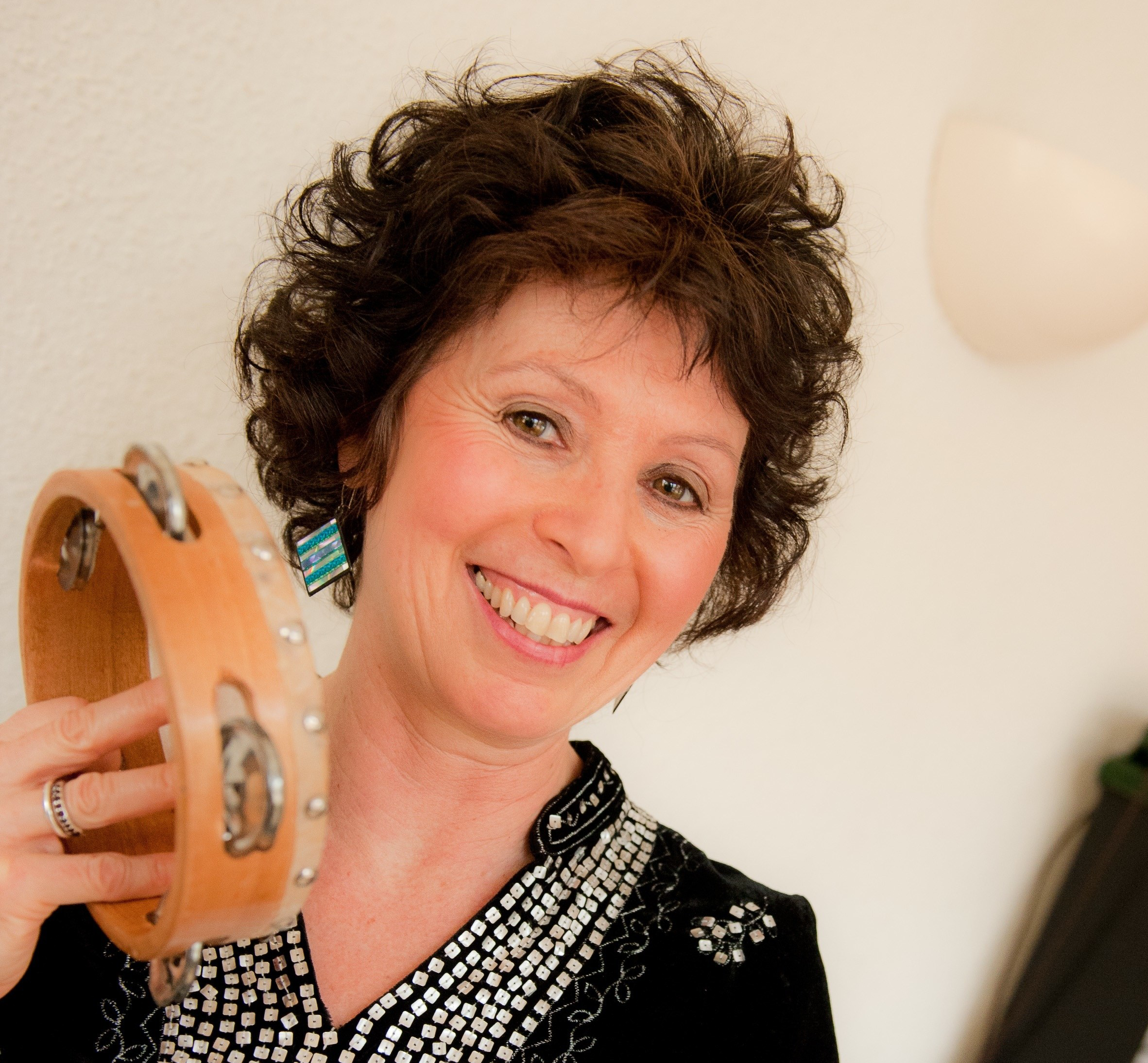
Noa Baum tells traditional tales and creates original stories, such as “A Father’s Gift.” (Photo: Sam Kitner)
CURWOOD: It’s Living on Earth, I'm Steve Curwood. “Hope for the holidays.” That's the theme we're exploring in the Living on Earth holiday special. Now, if you think about the ancient city of Jerusalem, “hope” might not be the sentiment that immediately comes to mind. It’s an area that’s been torn by sectarian violence, yet sacred to Muslims, Christians, and Jews. Noa Baum grew up in Jerusalem, and she does have hope, hope for peace and understanding. These days Noa lives just outside Washington, DC, and tells stories, traditional and original, to help build bridges of understanding among all people. She’s joining us to share some of those stories and explain why stories are important. Noa Baum, welcome to Living on Earth.
BAUM: Thank you very much, great to be here.
CURWOOD: Now in Jerusalem, I imagine, well, I don't think you see Santa Claus and reindeer and all that in the December holidays, and I also wonder what this time of year is like for you in Washington.
BAUM: Yes, well I certainly didn't grow up with Christmas, but since I've been living here in America I just love this time of the year. The season for me is a symbol of the great spirit of America, the spirit of generosity and inclusiveness. America is a place that strives and values diversity. America for me symbolizes a continuous quest for making things better and insisting on hope, and this time of year more than anything kind of encapsulates this spirit. Hope as a value, and I just love that.
CURWOOD: When do you get news from Jerusalem or talk with family there?
BAUM: Well, that's hard to stay hopeful. I have to admit that these are very dark times, especially for people who wish for peace, strive for peace, work for peace, but the bottom line is that I don't know how to live without hope, and I feel very lucky and privileged to be a storyteller, and grateful for stories because the stories help me stay connected to what's really important and stay connected to this spirit of faith and hope and generosity and inclusiveness – all the wonderful things about humanity. Stories, for me, they are healing, they help us discover the possibilities for better relationships with ourselves and our communities and all of humanity and especially in our Earth, and these are really important things in these times. Stories hold the possibility of peace. When you tell stories and you see the connections that people make, you know that peace is possible, and you have to stay hopeful.
CURWOOD: And so you use stories to help sustain hope. Tell me a story that is powerful enough to sustain one's faith and hope in these times.
BAUM: I don't think there is one. I think every person will find different meaning in different stories, but I want to share with you a little one that speaks to that connection.
CURWOOD: What's it called?
BAUM: It's called, “The Fire in the Forest”.
It is told that in every generation, there are times when hope threatens to leave this world. At such times it is said that the Baal Shem Tov, the great Jewish mystic, would go to a secret place in the forest, where he would light a special fire and say a prayer evoking the most sacred name of the divine, and the danger would be averted, and hope stayed alive.
In later times, when disaster threatened once again, his disciple the Maggid of Mezritch would go to that same place in the forest, but he would lift his eyes to the heavens and say, “Ribono Shel Olam, Master of the Universe, I do not know how to light that fire, but I can say the prayer. Please, let that be enough.”
And it was. And hope stayed in the world.
And still later, when his disciple Rabbi Moshe Leib of Sasov would face dangerous times, he would go to that same place in the forest and say, “Ribono Shel Olam, Master of the Universe, I do not know how to light the fire, nor do I remember the words of the prayer, but I found my way to this place. Please, let that be enough.”
And it was. Hope stayed alive. And many years later, when Rabbi Israel of Rizhyn came to lead the people, he would sit in his armchair with his head in his hands and say, “Ribono Shel Olam, we no longer know how to light the fire nor how to say the prayer. We cannot even find our way to that place, but we can still tell the story. Please, let that be enough.”
And it was. And it still is. For as long as stories are told, hope stays in this world.
CURWOOD: Noa, this is such a powerful story. Where does it come from? What location are you talking about here?
BAUM: It comes from Eastern Europe, where the Baal Shem Tov came from, and where people lived in dire straits and a lot of poverty and suffered a lot of persecution. But I think faith and stories sustain people in hard times. They remind us of the possibilities. They hold the flame of the future. They hold the flame of what's really important, and so I think stories were always used, humor was used, and stories were used to help lift the spirit in dark times.
CURWOOD: Do you have a real-life story for us, Noa?
BAUM: Oh, I have lots of those, but there's one story that's extremely dear to my heart. As part of my work, I use storytelling for peace-building, and I do interfaith workshops between Jews, Muslims, and Christians, where I use the power of story to get people to connect with each other and to start listening to each other and discover their common humanity. And at one of these workshops in Rochester, New York, one of the people who participated in my workshop was a Muslim man from Rochester, Dr. Bilal Ahmed, and he told a story that made my jaw literally drop. And I begged his permission to craft the story for telling, and to tell it to as many people as I can. And so he gave me the permission and this is the true story of a gift that he received from his father.
CURWOOD: And the name of this story?
BAUM: “A Father’s Gift.”
Bilal grew up in Lahore, in the Punjab province of Pakistan. When he was a little boy, there was a war between India and Pakistan, and he asked his father, “Why is there so much hate between the Muslims and the Hindus?”
His father said, “When you're older, I'll explain.”
A few years later when Bilal turned 13, his father took him to his uncle's house in the north. Bilal loved those visits. His uncle’s house was just about the coolest place that you could imagine. The entire house was built around a courtyard, at the center of which was a beautiful fountain. All the rooms of the house, all the doors opened to that courtyard with a fountain. There was an open stairway that led to an open corridor with more doors opening, looking down onto this courtyard. But the best part about that house was the banyan tree in the back. Bilal loved climbing on it with his cousins. They would spend hours there, just hanging out, telling jokes, telling stories.
Bilal was just about to run out there and join his cousins when his father said, “Bilal, come, it's time to answer your question.”
“What question?”
“Come.”
His father took him by the hand and led him up that flight of stairs and along that open corridor. He stopped before the one door, the only door that was ever locked in that house – the attic room. The jinn room. The jinn, the ghosts, the demons. His cousins were always telling stories about the ghosts and demons that lived behind that door.
“Eh, Baba — uh, uh, I don't want to go in there.”
“It's all right. There's something I need to show you. Come.”
His father unlocked the door and led him inside. He pulled the string that lit the single lightbulb from the ceiling. The room was musty and dark. There was old furniture around there and his grandfather's old musket and helmet from the world war. There was a big trunk there that his father now opened, and he took out a book, a big, leather-bound book.
And he said, “Bilal, this is our Bahi, the book of our family's history. It is very old. It is passed through the generations from the oldest son to the oldest son. That is why it is here in your uncle's house, for he is my oldest brother. I want you to look at it, but be careful. It is very old.”
Bilal opened the book. There were some empty pages, and then there was a page with names — oh, about 10 of them. He recognized his name, Bilal Ahmed Sahi, next to his brother Jamal and his sister Sarah. His mother, Naeema Cheema Sahi, his father Gulam Ahmed Sahi.
“Hey, that's us!”
“Yes, his father smiled. “That's us. That's our family. Keep looking.”
And so he started turning the pages. There were about 10 names on each page. He saw the names of cousins and uncles and aunts, people he knew, people he had heard about. Page after page of names.
Suddenly he noticed the names changed.
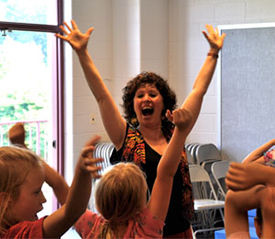
Storyteller Noa Baum is a Young Audiences educator in Maryland. (Photo: Sam Kitner)
He read, “Singh Gurmeet Singh — Singh Gurmeet Singh Sahi? That's not a Muslim name.”
“No,” his father said. “That is a Sikh name. They are your family too. Keep looking.”
And so he kept turning the pages. The paper was so old it was almost disintegrating in his hand.
And suddenly, he read, “Anil? What's that?”
“That's a Hindu name.”
[GASPS] “Hindu!”
“Yes, they are your family too. Keep looking.”
So he kept turning the pages. After some time it was no longer paper but parchment. And after a while, he couldn't recognize the handwriting or the language.
He looked up at his father and said, “I don't understand. What does this mean?”
His father said, “You asked about the hate. Remember? I wanted you to see this. I wanted you to see that God lives in everything. And don't you ever let anyone tell you to hate another, because you could see, they are all here – Muslims, Sikhs, Hindus, Christians, Jews. They are all your family.”
Well, Bilal was only 13-years-old and all he could think about was how to get out of that musty room and join his cousins on the tree.
Years passed. Bilal left Pakistan. He became a physician, married, three children. Settled in Rochester, New York.
And about two years after his father passed away, Bilal heard about The National Geographic’s Genome Project. The National Geographic’s Genome Project allows people to send samples of their DNA. They analyze it, and they can send you a map that traces the travels of your ancestors throughout history. And if you want, you can also find out who, still living in this world, is genetically related to you. Apparently, there are certain markers that are specific to certain population groups, and if your markers match the markers of someone else, they are genetically related to you, and they give them your e-mail.
And so, Bilal wanted to honor his father's memory, who was so interested in genealogy and history. He sent for the kit.
He took a swab from the inside of his cheek and put it in a little vial with a number on it. No name. No name at all.
And a few weeks later, the results arrived, and there was a great map of the entire world tracing the travels of his ancestors. And like each and every one of us upon this planet, they all began in Africa, and from there migrated over thousands and thousands of years up to Ukraine, Denmark, Poland. And about 5,000 years ago migrated to the area that today is called India, and 1,000 years ago settled in what today is called Pakistan.
And a few weeks later the emails began to arrive, the emails from his genetic relations. And he received an email from somebody called L. Frieberg. Another email came from someone called David Barry Baum, and another from Maurice Krasnow, Clayton Schultz, Jack Salzstein, Ed Leviten. It appears that according to the DNA results, the closest genetic relatives of Dr. Bilal Ahmed, the Pakistani Muslim, are Jews from a small village in eastern Poland.
And it was then that he remembered. He turned to his then-thirteen-year-old daughter and said,
“You know, when I was about your age, my father took me to my uncle’s house and showed me our Bahi, the book of our family's history.”
And he told her the story, and he's been telling that story ever since. He wants his children to always remember his father’s words:
“Don’t you ever let anyone ever tell you to hate another, because you can see they are all here – they are all your family.”
CURWOOD: They are all your family. That sounds like a critical message, wherever there's a conflict, huh?
BAUM: Well, you can understand why my jaw dropped, don't you?
[LAUGHS]
CURWOOD: What happens when you share stories like this?
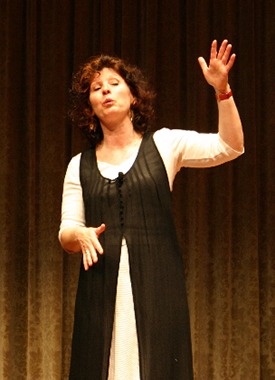
Baum’s stories draw from diverse cultures and her own Jewish heritage and personal experience. (Photo: Sam Kitner)
BAUM: Oh, my goodness, it’s the greatest gift that you can imagine. That's what allows me to stay hopeful in the world. When I share stories, you just feel that the audience breathes with you, and there's a silence that falls after the story ends. People wipe tears and their face shines, and then they come to me, and they start telling me their stories. It's wonderful. When you hear a good story, it evokes your own stories. It evokes your connection to who you are and to your ancestors and to your heart, and so people start sharing, and you discover how wonderful we really are as humans.
CURWOOD: Indeed, indeed. Noa Baum uses storytelling to build bridges of understanding. She's also author of the upcoming book, “A Land Twice Promised: An Israeli Woman's Quest for Peace.” Before you go, of course, if you have a book, there must be a story behind the book. Can you tell us briefly about it?
BAUM: Yes, and it's the story behind my friendship with a Palestinian woman that I met when I came to this country. And based on our friendship and our family stories, I created a performance piece called, “A Land Twice Promised,” and the book is a memoir of growing up in Jerusalem, coming to this country, meeting her, and the whole process of creating the show and the reactions that I've had around the world to it. It is about sustaining hope.
CURWOOD: Noa celebrates the holidays, and lives year-round for that matter, just outside of Washington, D.C. Noa, thank you so much for taking the time with us today.
BAUM: And thank you so much for having me. Happy holidays to you.
CURWOOD: Happy holidays to you. And if you'd like to get more information about Noa Baum, just go to our website, l-o-e-dot-org.
[MUSIC: “Erev Shel Shoshanim,” written by Josef Hadar]
Related links:
- Noa Baum
- About Noa Baum’s work with school children
- Noa Baum on “Why I Became a Storyteller”
- Noa Baum’s “Multicultural Tales that Connect Us”
CURWOOD: Living on Earth is produced by the World Media Foundation. Today’s crew includes Naomi Arenberg, Helen Palmer, Adelaide Chen, Jenni Doering and Lauren Hinkel. Tom Tiger engineered our show, with help from Jake Rego, Noel Flatt, John Jessoe, Miles B Smith, Michael Ponder and Jonathan Charry. Alison Lirish Dean composed our themes. You can find us anytime at l-o-e-dot-org, and like us, please, on our Facebook page - It’s PRI’s Living on Earth. And we tweet from @LivingonEarth. I'm Steve Curwood. Happy Holidays.
ANNOUNCER1: Funding for Living On Earth comes from the Grantham Foundation for the protection of the environment, supporting strategic communications and collaboration in solving the world’s most pressing environmental problems. Support also comes from Trinity University Press, publisjer of Moral Gorund; Ethical Action for a Planet in Peril, 80 visionaries who agree with Pope Francis, climt change is a moral issue for each of us. TU Press.org, and Gilman Ordway for coverage of conservation and environmental change. Living on Earth is also supported by Stonyfield Farm, makers of organic yogurt, smoothies and more. www.stonyfield.com.
ANNOUNCER2: PRI. Public Radio International
Living on Earth wants to hear from you!
Living on Earth
62 Calef Highway, Suite 212
Lee, NH 03861
Telephone: 617-287-4121
E-mail: comments@loe.org
Newsletter [Click here]
Donate to Living on Earth!
Living on Earth is an independent media program and relies entirely on contributions from listeners and institutions supporting public service. Please donate now to preserve an independent environmental voice.
NewsletterLiving on Earth offers a weekly delivery of the show's rundown to your mailbox. Sign up for our newsletter today!
 Sailors For The Sea: Be the change you want to sea.
Sailors For The Sea: Be the change you want to sea.
 The Grantham Foundation for the Protection of the Environment: Committed to protecting and improving the health of the global environment.
The Grantham Foundation for the Protection of the Environment: Committed to protecting and improving the health of the global environment.
 Contribute to Living on Earth and receive, as our gift to you, an archival print of one of Mark Seth Lender's extraordinary wildlife photographs. Follow the link to see Mark's current collection of photographs.
Contribute to Living on Earth and receive, as our gift to you, an archival print of one of Mark Seth Lender's extraordinary wildlife photographs. Follow the link to see Mark's current collection of photographs.
 Buy a signed copy of Mark Seth Lender's book Smeagull the Seagull & support Living on Earth
Buy a signed copy of Mark Seth Lender's book Smeagull the Seagull & support Living on Earth

